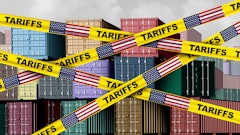
While cross-border commercial disputes have been going on for decades, tariffs struck most businesses as a distant, slowly shifting backdrop. Today they are front-page news, and change with the speed of a presidential press release. Executives who still treat duties as a temporary nuisance are misreading the terrain. Tariffs are now deployed as policy weapons; they can appear overnight, morph within weeks and disappear just as abruptly. In that climate, supplier contracts drafted for a stable tariff regime become trip wires for costly litigation or, worse, silent margin erosion.
Here's why companies moving food products across borders must revisit supplier agreements now and how proactive, interest-based negotiation can convert tariff volatility into competitive advantage.
Why every supplier agreement needs a tariff refresh
A single duty hike can wipe out a multipoint gross margin buffer. Consider April, when the Trump administration imposed an extra 10% tariff on most EU cheeses, a market worth nearly €2 billion. Days later, aluminum duties expanded, and Brussels fine-tuned its Carbon Border Adjustment Mechanism, altering levies on fertilizer inputs. Similar swings have hit olive oil, coffee and dozens of agricultural staples in just the past year.
Traditional boilerplate assigns “all customs duties” to whichever party clears the goods. That clause might have sufficed when tariffs were 2% and rarely fluctuated. It is hopelessly inadequate in a world where a 10-25% surcharge can appear mid-contract and bankrupt a supplier or prompt a buyer to declare force majeure.
Negotiation as an insurance policy for profit margins
The best hedge is creative, multi-issue bargaining well before trouble hits. Three contract features deserve immediate attention:
- Tiered price escalators: Instead of a fixed Free on Board (FOB) price, parties agree on a base price plus (or minus) clearly defined tariff bands. If duties exceed a threshold—say, 5%—price, volume or payment terms adjust automatically.
- Joint sourcing commitments: Buyer and seller collaborate to shift part of the bill of materials to lower-tariff jurisdictions or alternative Harmonized System (HS) codes, sharing both the costs and the savings.
- Rolling volume windows: Shipments are synchronized with tariff-free quota periods or seasonal duty suspensions, smoothing cash flow and inventory risk.
Such clauses act as shock absorbers; they compress time to solution from months of positional wrangling to days of collaborative tweaking, preserving both the relationship and EBITDA.
Case study 1: EU artisanal cheese entering the U.S. specialty market
A U.S. retailer importing French Comté recently faced an unexpected 10% duty, plus rumors of a further 20% surcharge. Rather than cancel the two-year supply deal, the parties engaged a mediator to facilitate a fast renegotiation. A three-part package resulted:
- Mixed-origin blends: The cheesemaker introduced a 30% share of tariff-exempt Swiss-style cheese aged in France but classified under a different HS code, lowering the blended duty rate.
- Deferred payment terms: The importer accepted 90-day payment linked to the U.S. prime rate, giving the exporter room to refinance the tariff cash outlay.
- Co-funded promotions: Both sides launched a marketing campaign that raised retail prices on premium cheese boards, recapturing some duty cost through higher sell-through.
The retailer’s gross margin slipped only 1.2 points—far better than the 5-point hit a straight passthrough would have caused—and supply remained intact ahead of the lucrative summer tourist season.
Case study 2: Mexican coffee under the new U.S. tariff regime
When the United States floated the idea a 10% duty on green coffee for the first time ever, a Mexican growers’ cooperative and a U.S. specialty roaster turned the threat into an opportunity. Because Mexican beans qualify for duty-free treatment under the USMCA, the supply chain was quickly reengineered:
- Origin-segmented SKUs: The roaster doubled volumes of single-estate Mexican beans, enabling the coop to certify full Mexican origin and maintain a zero tariff.
- Processing relocation: Decaffeination, once done elsewhere, moved to Mexico to keep transformation within the free-trade zone.
- FX-linked rebate: A peso-dollar collar shared currency gains or losses, ensuring the farmers benefited from tariff savings even if exchange rates shifted.
The roaster preserved cost stability, secured a “North American farm-to-cup” story for customers and strengthened ties with growers now cushioned against tariff surprises.
Best practices for negotiating amid tariff turbulence
| Practice | Rationale | Practical tip |
|---|---|---|
| Regulatory horizon-scanning | Duties now change via executive order; early warnings avert surprise cash calls. | Integrate trade-data APIs into ERP dashboards. |
| Multi-issue bargaining | Trading across price, volume, logistics and IP creates value beyond a single-line duty cut. | Prepare a concession matrix ranking each variable by cost to you and value to the counterpart. |
| Adaptive clauses | Built-in triggers slash renegotiation time. | Link price to specific tariff codes, with automatic reopeners if those codes change. |
| Mediation first | Neutral facilitation lowers temperature, speeds creative options and preserves relationships. | Require mediation before arbitration or litigation. |
| Scenario financial modeling | This visualizes win-win frontiers, curbing positional standoffs. | Share live spreadsheets during talks; update them jointly as policy shifts. |
| FTA and quota leverage | Rules-of-origin loopholes can neutralize duties. | Retain customs counsel early; redesign sourcing to maximize FTA content. |
From contract rescue to competitive edge
The messaging is simple; tariffs need not be a zero-sum tax. Companies that revisit contract architecture, treat negotiation as joint problem-solving and embrace mediation preemptively can turn external shocks into strategic advantage, while slower rivals litigate. These skills have become as essential for food importers and exporters as those needed to handle freshness, labeling rules and shifting consumer taste.
Key takeaways for the food sector
- Engage suppliers early. The moment a new duty is rumored, open dialogue; every day lost narrows the creative zone.
- Model total value, not just duty cost. Shelf life, brand reputation and consumer loyalty can dwarf the tariff line item.
- Design for agility. Use flexible volumes, origin swaps and shared marketing upside to absorb shocks.
- Institutionalize mediation. A standing mediation clause turns conflict into collaboration, producing faster, cheaper solutions.
Point No. 4 is worth emphasizing for business leaders and in-house counsel; it is far easier to undo a mediation clause than to introduce one after conflict has erupted. When drafted into the original contract, a mediation step is seen as routine and neutral—a part of how the parties agreed to manage risk. If both sides later agree they would rather go directly to litigation, they can simply waive it. But if no such clause exists, getting parties to agree to mediate once emotions are high and blame is flying is an uphill battle. Institutionalizing mediation is therefore not just a gesture toward civility—it’s a strategic tool that keeps options open when you may need them most.
Trade wars are now the background hum of global commerce. If your supplier contracts still treat tariffs as static taxes, the next headline duty hike will hit your margins, your inventories and perhaps your courtroom calendar. By adopting a negotiation mindset—creative, mediated, multi-issue—you can transform volatility into value. The cheese plate and the morning latte may never be tariff-free again, but with the right deal architecture, they can remain on consumers’ tables without blowing up the P&L statement.
That ultimately is the negotiator’s imperative: to turn external disruption into an internal advantage—one carefully crafted clause, and one well-timed conversation, at a time.
Disclaimer: This content is intended for general informational purposes only and should not be construed as legal advice. If you require legal or professional advice, please contact an attorney.


















